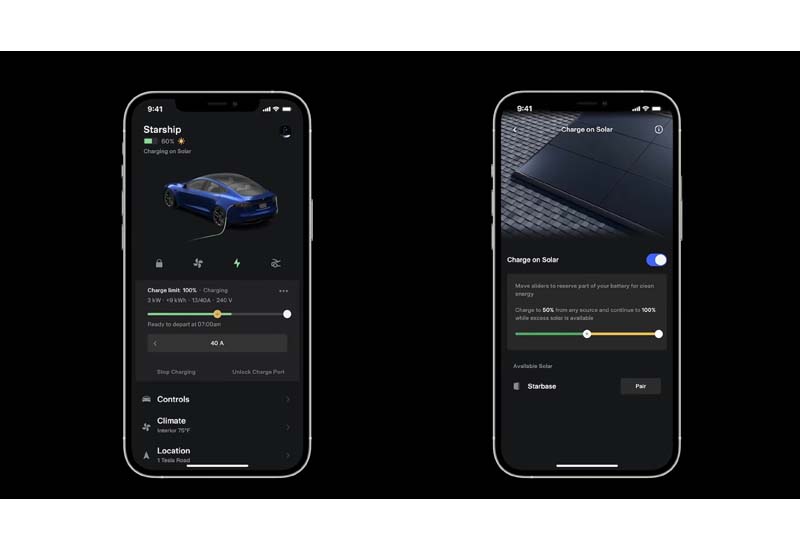Tesla has just launched a revolutionary new service in the US and Canada that allows Tesla vehicle owners to charge their cars using nothing but solar power. Dubbed “Charge On Solar” this service harnesses the excess solar energy generated by owners’ solar systems to power their Tesla vehicles.
As one of the biggest proponents of solar energy, Tesla CEO Elon Musk has finally put his words into action by converting solar energy into kinetic energy through this incredible new service. However, there is one caveat: Tesla owners must have a Tesla Powerwall installed in their home to use this feature.
To make Charge On Solar possible, Tesla provides a solution that uses the Powerwall to enable owners to charge their vehicles using excess solar energy. In March of 2023, Tesla updated their app to include this feature, which they initially called “Drive on Sunshine” feature allows Tesla owners with a Powerwall to charge their vehicles using the excess solar energy generated by their system.
Tesla has officially launched this feature in the US and Canada, and all users who have a Powerwall and a Tesla vehicle can use it. However, it’s essential to note that this feature is only available for Tesla Powerwall users, and those who use third-party solar storage cannot use it.
Before using this feature, the vehicle’s software system must be updated to version 2023.26 or higher, and the Tesla Powerwall must be updated to version 23.12.10 or higher. Additionally, the Tesla app must be updated to version 4.22.5 to coordinate both devices.
Once updated, Tesla owners can enable “Charge On Solar” in the Tesla app and set fee limits and preferred charging locations according to their needs. The vehicle will monitor the charging status in real-time and adjust the charging power every 10 seconds as needed. Users can also schedule the time for solar charging, making this feature incredibly convenient.
Tesla has also included some charging restrictions. If the vehicle’s current battery level is below the solar slider mark, the vehicle will use solar energy and the grid to charge. However, once the battery level exceeds the solar slider mark, the vehicle will automatically switch to using excess solar power only to charge until it meets the owner’s charging limit.
Since solar energy and household load are variable, users can raise the charging floor to the desired range to charge faster. The feature can also be scheduled to stop solar charging after a specific time if the user knows energy consumption will increase at that time. By using Charge On Solar, Tesla owners can significantly reduce their electricity bills.
Regarding Powerwall, it generates power from solar panels or charges from the grid during low-price periods and then provides power to homes during peak hours. It can also serve as a backup power source when the grid is down and can operate independently in emergencies to provide power to ordinary households.
Powerwall is more like a large “power bank.” The first-generation Powerwall had a capacity of only 6.4 kWh, while the second-generation Powerwall increased its storage capacity to 13.5 kWh and integrated a battery inverter.
In 2021, Tesla released the Powerwall+, which still has a capacity of 13.5 kWh. Powerwall+ integrates energy storage batteries, battery inverters, and photovoltaic inverters, making it a DC-coupled type household storage product more suitable for households with newly installed solar systems.
The operation of Powerwall can be divided into three modes, In Tesla app to set these three running modes to adjust the battery’s state of charge:
At the end of last year, Tesla launched the “Tesla Energy” function, which makes Powerwall equivalent to a small power station. When the power grid is in short supply, it can provide electricity and earn money.
In March of this year, Tesla announced that US customers could purchase Powerwall separately for $9,200, including $8,000 for Powerwall, $1,000 for the gateway Wi-Fi device, and $200 for accessories. However, Tesla will prioritize orders for entire solar systems. In addition, users can purchase Powerwall Direct service from authorized Tesla installers for between $15,000 and $18,000, and they can apply for a 30% federal solar tax credit during the purchase process.
With over 500,000 Powerwalls installed, Tesla is leading the charge in the household energy storage market. According to EVTank data, the global household energy storage market added 15.6 GWh of installed capacity in 2022, a year-on-year increase of 136.4%. Europe is an absolute home energy storage market, with a growth rate of 71% according to data from the European Photovoltaic Industry Association.
Related Posts:
Tesla (TSLA) Q2 2023 Earnings Beat Expectations: What to Expect
Tesla V4 Supercharger inclusion of a Bank /Credit card reader Contactless Payment
Charging Standards NACS vs CCS: How Tesla NACS is Changing the Game
